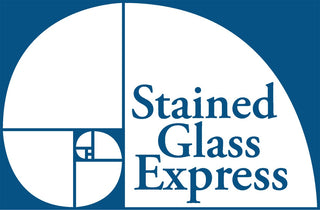Luminescent glass is different than iridescent glass. It is low-fire—not high-fire like iridescent—and is intended for reverse fusing.
What is reverse fusing? Reverse fusing means placing your piece face down on the kiln shelf and building backwards, fire-coated side down. If you are firing on a textured mold, place a piece of Thin Fire between your boron-treated mold and the glass. If you fire your piece with the coated side up or cover it with another piece of glass or you will lose the coating. If you are slumping and do not go over 1,200 degrees, you can place the luminescent side up and not lose the coating. the most up to date info on Food Safe with Wissmach Glass is here: Food Safety and Wissmach Glass - Paul Wissmach Glass Company LEFT: Luminescent glass fired with Thin Fire in between, with the coating facedown. RIGHT: Luminescent glass fired facedown, directly on the mold.
LEFT: Luminescent glass fired with Thin Fire in between, with the coating facedown. RIGHT: Luminescent glass fired facedown, directly on the mold.
Firing Schedules: Courtesy of Petra Kaiser and Wissmach Glass
Standard Fusing Schedule – 2 Layers Thick
Segment 1: 600°F/hr. up to 1,000°F, hold for 10 minutes
Segment 2: Full/9,999 up to 1,410°F, hold for 10 minutes
Segment 3: Full/9,999 down to 950°F, hold for 60 minutes
Segment 4: 100°F down to 700°F, hold for 1 minute
Tack Fuse, Polishing and/or Slumping into a Mold
Segment 1: 300°F/hr. up to 1,000°F, hold for 10 minutes
Segment 2: Full/9,999 up to 1,300°F or 1,350°F (depending on your desired results), hold for 10 minutes
Segment 3: Full/9,999 down to 950°F, hold for 60 minutes
Segment 4: 100°F down to 700°F, hold for 1 minute
Draping over a Mold and/or Polishing
Segment 1: 300°F/hr. up to 1,000°F, hold for 10 minutes Segment 2: Full/9,999 up to 1,200°F or 1,220°F (depending on your desired results), hold for 10 minutes Segment 3: Full/9,999 down to 950°F, hold for 60 minutes Segment 4: 100°F down to 700°F, hold for 1 minute
NOTE: Not all kilns are alike. Your kiln size, controller type and individual project may require some alteration to the schedule for best results.
Iridescent glass is made by Oceanside, Bullseye and Youghiogheny. Also Wissmach non fusible. When firing it can be placed up or down. This info from Oceanside.
Iridescent glasses have a micro-thin layer of metallic crystal creating a reflective surface that shimmers in rainbow, silver, or gold tones. Because of its metallic nature, the coating has specific characteristics that are important to understand as you plan fused glass projects.
The metallic coating doesn’t melt so it resists bonding:
If you were to try to fuse two iridized surfaces facing together, they will not bond well, if at all.
When stacking a design on top of an Iridized surface, you may get more of a tack-fused look than you intend. Use this to your advantage to create very dimensional work or adjust your schedule.
To fully clear cap an Iridescent glass, make sure your piece of clear is slightly larger (between 1/8" and 1/4" on all sides) so that it has enough area to bond with the edges of the glass below.
The metallic coating doesn’t stretch:
This is why a crackling effect can be seen when Iridescent glasses are allowed to spread — especially when the irid surface is on top, face-up. Enjoy the look—alternately, dam pieces or construct them using a circular design (where the glass tends to draw inward when full-fused) to minimize the effect. Clear capping produces more of a pinching or crinkling look as the clear presses into the coated surface below.

Picture from Angelas Art Glass on Etsy.
The same coating is more dramatic on darker glasses:
The rainbow iridescence on Clear or White is much more subtle and delicate than on darker colors or Black, which is the most dramatic.

Firing for Different Effects:
Irid side down: in this example, the iridescent surface of the glass is placed face down on the kiln shelf paper, with a piece of clear on top. This look can make a lovely matte finish for either the top or bottom of a piece.
Irid side up: in this example, the iridescent surface of the glass is placed face up on top of a piece of clear. This gives the most opportunity for glass to spread and crackle.
Irid side up and capped with clear: in this example, the iridescent surface of the glass is placed face-up and capped with a slightly larger piece of clear glass on top.

Using Clear Textured Iridescent Glasses:
Place the texture side down onto a darker base glass. Although the texture will flatten using a full fuse, the irid design from the texture will still be visible with interesting distortions from the texture. Do small test fires to know.

In smaller pieces of Iridescent Clear or other light colors, it can be difficult to tell which side has the coating. Simply scratch both sides with your fingernail--the irid surface will grip more than the smooth side.

